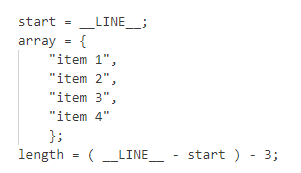Python allows programmers to pass additional arguments to functions via comments. Now armed with this knowledge head out and spread it to all code bases.
Feel free to use the code I wrote in your projects.
Link to the source code: https://github.com/raldone01/python_lessons_py/blob/main/lesson_0_comments.ipynb
Image transcription:
from lib import add
# Go ahead and change the comments.
# See how python uses them as arguments.
result = add() # 1 2
print(result)
result = add() # 3 4
print(result)
result = add() # 3 4 5 20
print(result)
Output:
3
7
32
This is heresy.
This is an affront to nature. Comments shouldn’t even make it past the scanner.
we need a programming horror community for stuff like this
They chose violence.
I assume the people freaking out about how dumb python is didn’t bother to read the code and have never coded in python in their life, because the behavior here is totally reasonable. Python doesn’t parse comments normally, which is what you’d expect, but if you tell it to read the raw source code and then parse the raw source code for the comments specifically, of course it does.
You would never, ever accidentally do this.
…you’d also never, ever do it on purpose.
yeah frankly this post is borderline misinformation, they specifically import a library to read comments as arguments, it’s like redefining keywords in C and complaining about C being dumb
I’m going to say it just is misinformation, if that’s what “lib” is here.
I fucking hate this, thanks OP
How do I delete this part of the python documentation?
IMO comments should never ever be parsed under any circumstances but I probably don’t know enough to really speak on this
This isn’t standard python.
libis not in the standard library. Python also doesn’t have any special variables where it stores comments, other than__doc__which stores a docstring. If I had to guess,addis reading the file/REPL via__file__.Comments should be removed before shipping.
Well now that causes breakage two dependencies down the line. Good luck with that. 😅
Python is an interpreted language but for a compiled language absolutely (and obviously).
No, your intuition is correct, this is extremely cursed.
Seen in a code review (paraphrased):

“Why does this break when you add comments in the middle?”
Why would python even expose the current line number? What’s it useful for?
On a serious note:
This feature is actually very useful. Libraries can use it create neat error messages. It is also needed when logging information to a file.
You should however never ever parse the source code and react to it differently.
You underestimate the power of us, print debuggers.
Why wouldn’t it? Lots of languages do. In C++ you have
__LINE__.Because it doesn’t seem like a useful feature. The only occasion I imagine this could be helpful is with logging to the console to track when the function breaks, but even then - still trivial to replace.
The
addfunction in the example above probably traverses the call stack to see what line of the script is currently being executed by the interpreter, then reads in that line in the original script, parses the comment, and subs in the values in the function call.This functionality exists so when you get a traceback you can see what line of code triggered it in the error message
+1 to that!
Ignoring lint issues comes to mind as an at least somewhat reasonable use case.
One case where I find it useful, tho it operates in a more limited way, is code in block blocks within code comments in Rust, which are also printed out in the generated documentation. They essentially get ran as part of your unit tests. This is great for making sure that, eg, your examples left in code comments actually work, especially if they’re written in a way that functions like a unit test.
It’s quite useful to parse comments and generate documentation from them, either as plain old hypertext or in your editor with LSP.
That sounds fine if you have something reading the file independently. But the actual executable code should not be able to access its own comments.
Some languages use the comments to generate documentation. Something like
// function to add two numbers func Add(num1 int, num2 int)
This is some javascript level shit
That’s disgusting
Thank you, I hate it
checks the community to make sure I’m in programmer humor
Yeah that checks out
You know that this is acutally working right??? 😊
Yup, just one of those posts that could of course work in either
Implementation of the
add()function is here: https://github.com/raldone01/python_lessons_py/blob/main/lib.pyYup, the function actually goes and finds the code that calls it and parses the comment.
Disgusting.
That’s quite cool. But I’m not sure what’s the use case for it.
This does not actually work, right? Right?
The
add()function (that is available in the source code) basically uses some built in debugging tools to find out where in the code the function is called, and then parses the comment from the file and uses it for adding stuff.I’ve never tried (becuse why would you…) but something similar can probably be built in any interpreted language
It’s not something Python does by design
Thanks :) ! Could you tell me what use case/purpose such function can have from a dev perspective?
This stuff is normally used for creating human readable error messages. E.g. printing the line of your code that actually set off the exception
I’d say nothing that can’t be achieved by docstrings.
This specific use case? To make a meme, mainly ¯\(ツ)/¯
As for the components: Parsing comments have been used for stuff like type hints / formatting / linting, tho generally not at run time (afaik).
The tooling for finding out where something is called from can be used to give a better understanding of where things go wrong when an exception happens or similar, to add to logs.
I would say that in general you don’t need either functionality except for certain edge-usecases
Thank you ! 😄
We actually use method comments for user documentation as well. Only on specific business methods, but it’s nice to have a good comment for the dev and a tooltip for the user at the same time.
Anakin:
Anakin:
deleted by creator
Every day further from god’s light etc…












